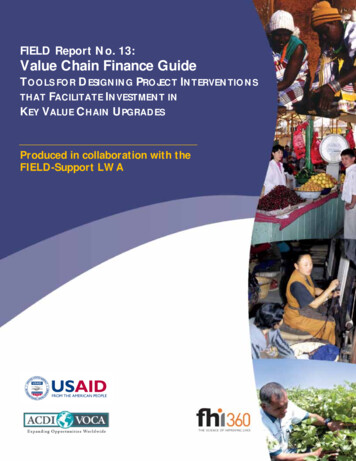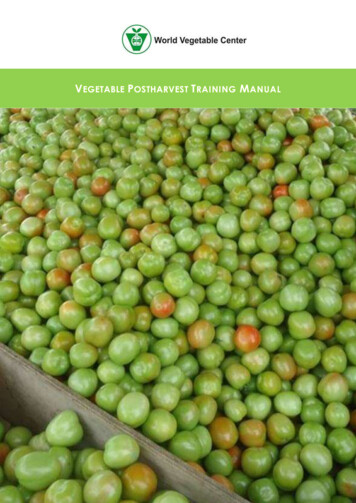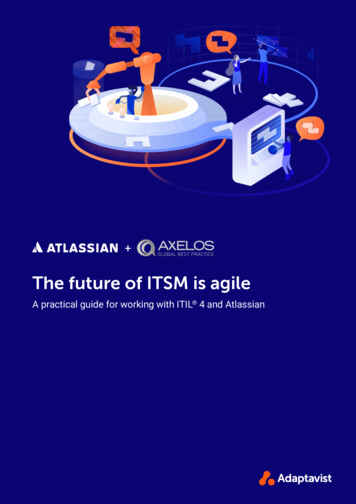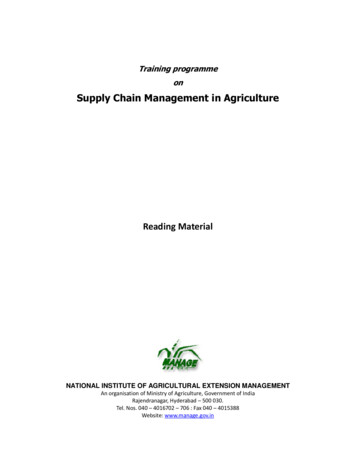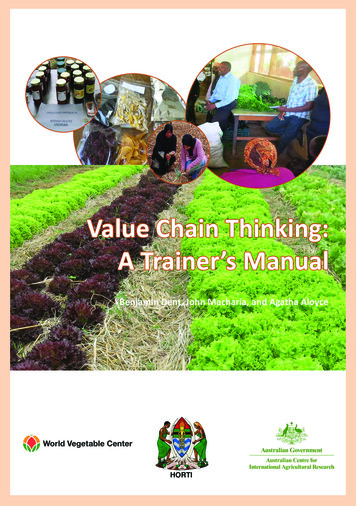
Transcription
Value Chain Thinking:A Trainer’s ManualBenjamin Dent, John Macharia, and Agatha AloyceHORTI
Published byWorld Vegetable CenterP.O. Box 42 Shanhua, Tainan 74199TaiwanT 886 6 583-7801F 886 6 583-7801E .orgWorldVegetableCenter@go vegetablesWorldVeg Publication: 17-825ISBN 92-9058-226-X 2017, World Vegetable CenterThis work is licensed under the Creative Commons Attribution-ShareAlike 3.0 UnportedLicense. Please feel free to quote or reproduce materials from his report. The World VegetableCenter requests acknowledgement and a copy of the publication or website where the citationor material appears.Suggested citationDent B, Macharia J, Aloyce A. 2017. Value Chain Thinking: A Trainer’s Manual. World Vegetable Center,Shanhua, Taiwan. Publication 17-825. 57 p.
Value Chain Thinking:A Trainer’s ManualBenjamin Dent1, John Macharia2, Agatha Aloyce3Value Chain Management International (VCMI)2World Vegetable Center (WorldVeg)3Horticultural Research and Training Institute (HORTI-Tengeru)1
AuthorsDr Benjamin Dent, a PhD in Sustainable Value Chain Analysis from the University ofQueensland, Australia, is a Senior Associate with Value Chain Management International.He specialises in improving supply chains competitiveness through collaboration andunderstanding markets. He advises multinational firms, small and medium enterprisesand family farms/smallholders, and partners with NGOs, universities and developmentorganisations, most recently in North America, Australia and Eastern and SouthernAfrica. He is the co-author of A Guide to Value Chain Analysis and Development forOverseas Development Assistance Projects. Contact: benjamin.dent04@gmail.comDr. John Macharia holds a PhD in Agribusiness from the University of Queensland,Australia. His key objective is to promote responsiveness, profitability, and innovationof agricultural small and medium enterprises in Eastern and Southern Africa for greatervalue to consumers, higher returns and environmental resilience. His professionalbackground encompasses project management, community engagement, consumer andmarket research, business plan development, capacity building, gender mainstreaming,and value chain analysis. He has authored/co-authored several publications, users’ guidesand tools kits on various agri-food supply chain topics.Ms. Agatha Aloyce, an Agricultural Research Officer in the Tanzanian Ministry ofAgriculture, is a pathologist and horticultural value chain expert. She served as thecountry coordinator on the ACIAR-funded “Improving income and nutrition in Eastern andSouthern Africa by enhancing vegetable-based farming and food systems in peri-urbancorridors” (VINESA) project and in this role delivered value chain thinking training to 120farmers. She facilitated the formation of a Vegetable Value Chain Farmers’ group in theArusha region to foster farmers’ collective action to meet consumer demand and earnmore cash. Ms. Aloyce coordinated several value chain programs including the Australia Africa Agribusiness course, in which she facilitated access of participants to local site visitsthrough her networks.
ContentsEXECUTIVE SUMMARYCHAPTER ONE: Course Overview1.1 Intended audience1.2 Course principles, structure and relevance1.3 Ensuring gender sensitivityCHAPTER TWO: Introduction to Value Chain Thinking2.1 What is a Value Chain?2.2 What is Value Chain Thinking?2.3 Value Chain Thinking in practice2.4 Common mistakes in Value Chain ThinkingCHAPTER THREE: Training Activities3.1 Course structure3.2 Activity 1 – Mapping the chain and reducing waste3.3 Preparing for Activities 2, 3 and 4: Identifying market opportunities3.4 Activity 2 – What do consumers want?3.5 Activity 3 – What do customers want?3.6 Activity 4 – Creating Value3.7 Activity 5 – Postharvest opportunities for farmers3.8 Activity 6 – Working as Partners: How to pick partners and build relationships3.9 Activity 7 – Learning from an existing vegetable value chain3.10 Activity 8 – Gender equity in Value Chains3.11 Activity 9 – Preparing an Action PlanCHAPTER FOUR: 7 Steps to Connecting Farmers to New Markets77781010111323242424292931323637404142Step 7: Finalise action plan with farmers4446485051545556References57Step 1: Create a list of potential market opportunitiesStep 2: Identify farmers’ strengths and limitationsStep 3: Compare market opportunities with farmers’ strengths and limitationsStep 4: Investigate the short list in detailStep 5: Let farmers decideStep 6: Value Chain meetings
EXECUTIVE SUMMARYValue chains are interactive systems, with theflow of products, money and information highlydependent upon relationships throughout thesystem. Value Chain Thinking takes a whole-ofchain perspective, emphasising the importance ofmarket orientation and collaboration. It highlightshow effective partners align their skills, resourcesand behaviour to deliver higher value products andservices and to reduce waste, with the resultantfinancial returns being distributed equitably tosustain partners’ commitment.This manual helps trainers to teach Value ChainThinking principles and decision-making processes,and provides a structure for participants todevelop an Action Plan which draws together theirskills in production, postharvest activities andValue Chain Thinking. It was developed and testedduring “Training of Trainers” courses in Ethiopia,Malawi, Mozambique and Tanzania in 2013-2017under the Australian Centre for InternationalAgriculture Research (ACIAR)-funded projectImproving Income and Nutrition in Eastern andSouthern Africa by Enhancing Vegetable-basedFarming and Food Systems in Peri-urban Corridors(VINESA).The case studies presented are about vegetablesin developing countries, and the activities aredesigned for vegetable smallholders in similarcountries. However, this manual could be readilyapplied to other agricultural sectors in a variety ofcontexts, and to other members in those chains,whether extension officers, input suppliers,traders or retailers. It will help them to: developa whole-of-chain perspective, and a marketorientated focus; understand the interdependencewithin chains, and consequently the benefit ofbuilding effective partnerships, rather than relyingon transactional relationships; assess marketopportunities and the suppliers and customersneeded to exploit them; to select, produce andprocess the most promising crops; and to developand execute an action plan that will increase theirincome.Chapter One gives an overview covering theintended audience; course principles, content andsources; and importance of gender sensitivity.Chapter Two gives an introduction to Value ChainThinking, including: what is a value chain; howValue Chain Thinking increase farmers’ incomes;and Value Chain Thinking in practice.Chapter Three provides a briefing for the trainingcourse itself. It sets out eight activities fromwhich trainers can select how best to help eachparticipant develop an action plan. These include:identifying market opportunities, especially theproduct qualities and service levels needed toaccess those opportunities; mapping the valuechain, from critical input suppliers to the finalcustomer and end consumers, and so learningwhere value can be created and waste can bereduced across the whole chain; prioritising theirown contribution to the value chain: what skills,resources and inputs should they focus upon tobecome a key partner in the chain, and buildingrelationships with other key partners.Chapter Four offers a 7-Step Guide to ConnectingFarmers to New Markets. This is a low cost,participative process to identify and evaluatemarket opportunities, and then develop an actionplan based on Value Chain Thinking. To downloada separate .pdf of this cal-guide fact-sheetrev2-pdf/
A Trainer’s Manual 7CHAPTER ONECourse Overview1.1 Intended audienceThis course is designed for intermediate, literatetrainers from training, research and extensionservices providers. While prior knowledge of valuechain principles or practice is not essential, courseparticipants need to be experienced, trained andenthusiastic about how developing Value ChainThinking (VCT) will supplement smallholders’production and postharvest skills and increasetheir income. While the course can be given basedon the activities identified in Chapter Three, itwould be helpful if the trainers have the ambition,knowledge and confidence to adapt the genericmaterial to suit their local circumstances (culture,market, products, etc.). Additionally, it would behelpful if those selected for this training havesome understanding of how gender issues couldenhance or impede the application of Value ChainThinking within agri-food supply chains. During thetraining, it is necessary to recognize that genderconstraints may prevent men and women frombenefiting equitably from participation in highvalue agri-food chains.1.2 Course principles,structure and relevance1.2.1 Principles behind VCT courseBuild participants’ capacity: One of the coreobjectives of Value Chain Thinking is movingfarmers from an attitude of “Selling what Iproduce” to “Producing what I can sell”— i.e., donot grow as much as possible, nor grow just moreof the same, but rather grow what can be soldmost profitably. However, there is no single ‘rightanswer’; what is best for each participant willdepend upon their own situation, for example, thebalance between growing for their family’s ownconsumption and growing for sale, and the land,labour, finance and other resources to which theyhave access. Market opportunities are dynamic,so participants need the skills to adapt to thefuture. Accordingly, this trainers’ course providesa framework for individuals to make their owndecisions and action plans.Adapt to local conditions: The course needsto reflect farmers’ circumstances in terms ofproduction environment; market opportunitiesand constraints, especially routes to market; andthe culture of their operations. Trainers shouldreflect on their local knowledge and try differentapproaches, then record what they tested andwhat they concluded so they can build on theirown experiences. This should include the topics,issues and activities covered; the exercises andexamples used; the value chain maps producedand the action plans which resulted. This may wellinclude the need to train other members of valuechains.Participative: The manual is designed aroundexercises, not lectures. This in line with the saying:“What we hear, we forget; what we see, weremember; what we do, we understand.”Built-in flexibility: When we tested the manual,it became clear that rather than a linear design,which prescribed that trainers work through allnine activities in turn, the course needed to allowtrainers to select activities based on the needsof the trainees and their own confidence andcomfort with the material. Hence the structurewas revised, as set out in the next section.1.2.2 Course structureThe course structure is based on participantslearning about Value Chain Thinking and thendeveloping their own Action Plan (Figure 1.1).How many of the activities are covered willdepend on the trainer’s experience, the trainees’needs, and the time and resources available.
8Value Chain Thinking1.2.3 SourcesThe approach proposed incorporates experiencefrom previous ACIAR projects, the LearningAlliance Process developed by the Dutch RoyalTropical Institute in Ethiopia (Belt et al., 2011);USAID’s Value Chain Systems Training, and anumber of projects in collaboration with ProfessorsRay Collins and Andrew Fearne, and AssociateProfessor Laurie Bonney. In particular, applying avalue chain framework to development projects isprovided in another ACIAR publication, “A guide tovalue-chain analysis and development for overseasdevelopment assistance projects” (Collins et al.,2015; download at http://aciar.gov.au/publication/mn178); Chapter Two draws directly on the deeperexplanation offered in that guide.1.3 Ensuring gendersensitivityWomen undertake many of the core roles in manyagri-food value chains in developing countries, yetwomen have a subordinate position in many ofthose societies (World Bank, 1990). For example,there are complicated sets of social relations andnorms conferring access to, use of, and ownershipof land between men and women. Genderrelations and power, as well as overlapping legaland customary law, determine these rights withinboth the household and community (Moser,1993). Typically, these social relations also preventwomen from participating in and benefitingFigure 1.1: Value Chain Thinking training course structure
A Trainer’s Manual 9from Value Chain Thinking, particularly in termsof access to resources, decisionmaking andnegotiations. To achieve the desired developmentoutcomes, all activities in this manual must bedesigned to be sensitive to gender distinctions,and delivery must integrate women and theirdistinguishing needs. Trainers need to understandthe relevance of gender in the context, design,implementation and monitoring of this trainingcourse, and use this opportunity to strengthenwomen’s role in vegetable value chains (Kabeer,2003). It is essential that this training is providedin ways that are as accessible and relevant tofemale participants as to male ones. This mightinvolve training women and men separately,providing childcare, or covering expenses such astransport.ReferencesBelt J, Goris W, Debela S, Kefyalew F, Smulders E,Visser P (2011). Learning and earning: How avalue chain learning alliance strengthens farmerentrepreneurship in Ethiopia. KIT Bulletin 395,KIT Publishers, Amsterdam. Available at hens-farmer-entrepreneurship-ethiopia/Collins R, Dent B, Bonney L (2015). A Guide to ValueChain Analysis and Development for OverseasDevelopment Assistance Projects. Available athttp://aciar.gov.au/publication/mn178.Kabeer N (2003). Gender mainstreaming in povertyeradication and Millennium Development Goals.Commonwealth Secretariat, London.Moser CON (1993). Gender Planning and Development:Theory, Practice and Training. Routledge, London.World Bank (1990). Agricultural Growth andStrategic Options, Washington DC, USA.World Bank (1990). Agricultural Growth and StrategicOptions, Washington DC, USA.
10 Value Chain ThinkingCHAPTER TWOIntroduction to Value Chain Thinking2.1 What is a Value Chain?There are many definitions of value chains, andmuch discussion over the distinction betweenvalue chains and supply chainsIt is essential thatthe approach used in this training is set out clearlyand applied consistently.Value chains are interactive systems, withproducts, money and information flowing throughthem, all reliant on relationships (Fearne andHughes, 1999) (Figure 1.2). The critical point isthat the only source of money into the chain(other than credit or subsidies/aid) comes fromconsumers. Accordingly, a value chain’s economicsuccess depends on delivering a product fromseed, through production, processing andtransport, which appeals to those consumersbeing served by the retailer. Achieving thatobjective relies on the effective flow and useof information along the chain, which usuallyFigure 2.1: A generic value chaindepends on the extent of trust and commitmentbetween trading partners (Macharia et al., 2013).The critical lesson is that farmers’ decisions shouldbe taken based on an understanding of marketopportunities and the whole chain, rather thanlooking at their own part of the chain in isolation.Within value chains, individuals or firmscan undertake more than one function, andinformation does not have to flow linearly:seed suppliers can conduct their own consumerresearch while farmers can speak directly toretailers. However, if each actor only knows abouttheir own direct suppliers and customers, becauseof chain-wide interdependence in the flow ofproducts and money, they are vulnerable to lowerreturns because of unknown problems in otherparts of the chain.
A Trainer’s Manual 112.2 What is Value Chain Thinking?One way of understanding Value Chain Thinking isto contrast supply chains and value chains.Think of the money in both chains as a pie.Consumers determine the size of the pie becausethey decide whether or not they are going to buya product and how much they are willing to payfor it.Supply chains push products from upstream, withfarmers adopting a production-focused attitudeof “selling what they produce”. Products do notreflect the specific requirements of particularmarket segments, and so consumers decidewhat to buy mostly on price, rather than theirpreferences (Collins et al., 2015). As a result, toincrease their incomes, everyone in the chain hasto compete with each other to try to make theirslice of the pie bigger by making someone else’sslice smaller (Figure 2.2). In these supply chains,everyone behaves in an opportunistic manner.Customers switch suppliers whenever they canget what they need a little cheaper elsewhere;suppliers will let down customers if they get abetter offer from someone else. The relationshipsare transactional: there is neither trust norcommitment. Information about product prices,volumes and standards does not flow freely alongthe chain.In contrast, a value chain’s product is pulled byconsumers, with farmers adopting a marketorientated attitude of “producing what theycan sell” (Collins et al., 2015). Everyone workstowards supplying the same market opportunity,and so avoids competing solely on price. The piegets bigger with everyone’s slice growing withoutstealing part of someone else’s (Figure 2.3).Relationships are stable and stronger, with greatercollaboration and sharing of information, becausepeople along the chain want to work together aspreferred suppliers and customers.‘Growing the pie’ requires Value Chain Thinking(Figure 2.4). This involves a collective decisionamongst those involved in the chain to changetheir objectives and behaviour. In effectivevalue chains, firms do not act in isolation,Figure 2.2: Supply chain strategy of growingindividual slices of the piebut work together to grow, process anddeliver products to meet the expectations ofspecific consumers, which means retailers canattract more shoppers— and if the productmeets their particular consumers’ needs,they might even be willing to pay more.Figure 2.3: Value chain strategy ofcooperatively growing the pie
12 Value Chain ThinkingAn efficient chain produces what shoppers wantwhen they want it; there is less wastage, andrevenue increases. When the benefits of this areshared across the chain, suppliers and customersbecome partners.Value Chain Thinking increases farmers’ incomeswhen they: understand market opportunities,and focus on producing what thoseconsumers want and,become preferred suppliers by providingmore suitable products and superiorservice to customers, for example interms of reliability.Essentially, this involves reducing the intensity ofcompetition. When a farmer produces the sameproduct as many other farmers and does notoffer better service to customers, the only waycustomers and consumers choose suppliers is onprice. Contrastingly, Value Chain Thinking enablesa farmer to stand out from the crowd by growing acrop suited to a particular market, and by offeringbetter services to those customers which giveaccess to that market. The farmer thus becomesa much more attractive supplier, and reducescompetition since customers make choices basedon factors other than just price. The potential forthe farmer’s income to increase rises.Supply Chain ThinkingValue Chain Thinking“Growing your slice”“Growing the pie”Compete on priceIndependence and self-interestFlexible, transactional relationshipsShort-term tradingSuppliers chosen on quality and costSuppliers are price takersOpportunismLimited information sharingCompete on valueInterdependence and mutual interestStable, collaborative relationshipsLong-term planningSuppliers selected for quality, skills, service and partnershipPrices negotiatedCommitmentOpen communicationFigure 2.4: Contrasting Supply Chain Thinking and Value Chain Thinking
A Trainer’s Manual 132.3 Value Chain Thinking in practiceValue Chain Thinking can be considered as a fourpiece puzzle, with every piece needed to completeit (Figure 2.5). Each piece is explained below.Puzzle Piece No. 1: Understand ConsumersSince consumers determine the ‘size of the pie’, itis essential to understand what they want from aparticular product. This may include asking suchquestions as: What product characteristics will changetheir behaviour?How much do they buy?How frequently?How many of them buy it?Where do they buy it?How much they are willing to pay for it?In considering these questions, it is critical torecognise that consumers are not all the sameand they do not want the same product, so valuechains need to understand specific consumers’needs, and how they can work together todeliver those needs. Only then can the chain‘grow the pie’ by selling more, ideally at a higherprice, to those specific consumers. This involvesdeciding priorities for the resources (time,money, skills, land, etc.) for each member of thechain. For example, retailers need to understandhow to meet shoppers’ needs better than thecompetition, with seed suppliers, farmers andwholesalers using their resources to supplyretailers with the quality and quantity of productsmost suitable for their shoppers. Two case studiesof this market-oriented approach are given in CaseStudies 1 and 2 highlighted in the boxes.Figure 2.5: The Four Piece Puzzle of Value Chain Thinking
14 Value Chain ThinkingTo increase the ‘size ofthe pie’, value chainsneed to understand whatconsumers want, especiallyhigher values consumersThere are many different types of marketopportunities, which include: Displacing existing suppliers whosecustomers are finding them unreliableImport substitutionNew productsOpportunities currently being missed,for example supplying new consumersegments, such as non-indigenousethnic minorities, or a returningdiaspora who have developed newtastes while abroadThis process can include processing products inways to make them more attractive to potentialconsumers. For vegetables, this may includeincreasing their shelf-life, convenience, or taste(Figure 2.6).It is critical to distinguish between adding valuebased on personal preferences or assumptionsabout consumers, and value creation based onmarket research. Anecdotes are not evidence.Overall, the ‘understanding consumers’ pieceof the Value Chain Thinking puzzle should leadfarmers to ask:1. What products, andwhat characteristicsof those products, areshoppers looking for?2. Which crops and howmuch should I grow; andhow should I grow them?3. Can I process thosecrops to make them moreattractive/valuable toconsumers?
A Trainer’s Manual 15Figure 2.6: Processed products areattractive to consumers and have longershelf-life. Food can be dried and packaged,or processed into sauces, jams and otherproducts.
16 Value Chain ThinkingBox 2: Case study on Iraq al AmirWomen Association, Ammam, JordanMarket opportunity: Vegetables whichguarantee safer production systems, and betterreturns for farmersCASE STUDY 1: Harvest of HopeVegetable Box Scheme, Cape Flatsownship, Cape Town, South AfricaMarket opportunity: A group of consumerswanting healthier vegetables grown with less/safer chemicals.Product: Organically grown vegetables,delivered directly to shoppers initially viapick-up points at primary schools, but nowwith 29 collection points. The approach helpsto offset the unavoidable variability in yield,timing and quality of different crops, since thevegetable boxes’ content can be adjusted toreflect availability. Collectively, the farmersearn US 7000/month.Participants: Now involving over 140urban smallholders, organised by AbalimiBezekhaya (Farmers of Home) as part ofHarvest of Hope, established in 2008.Benefits to farmers: Access to markets outside their localcommunity; Secure contracts/monthly income; Bulk purchase of inputs reduces costs,and Working in the packing shed earnsadditional income and helps to buildfarmers’ understanding of downstreamactivities, which feeds back into how theyfarm.As a further example of Value Chain Thinking,the organisers responded to feedback fromtheir consumers, some of whom criticisedthe lack of variety and out-of-season producecaused by reliance on locally-grown freshproduce. As a result, the organisers introducedsupplementary products from other sources,and so attracted more consumers.Further details: https://www.youtube.com/watch?v 4-qsAB7pw-UProduct: A brand of low/safe pesticideproduced spring/green onions, with 75% offinal price paid to farmers. The farmers alsouse a new variety of onion, which does notflower as early, can be harvested later whenprices were higher, and has a longer shelf-life.Participants: 42 farmers working within awomen’s cooperative.Benefits to farmers: On average, householdsimproved their income by 20%.The project required improved productionskills in soil fertility and pest and diseasemanagement, as well as extending activitiesinto postharvest processing by cleaning theonions in the field, grading at householdlevel, and then packing at cooperative level.The association developed its own brand tocommunicate origin and responsible/healthyproduce to consumers, improving recognitionand aiding repeat purchasing. Farmers alsoplant seedlings rather than seed to shortencrop cycles and reduce losses from seeds notgerminating. Participants are charged a fee of8% of their gross revenue from sales towardscosts of marketing, packaging and transport.Further details: Urban Agriculturemagazine, Number 25, September 2011,page 54. UAM%2025 0.pdfThe association’s own‘responsible production’brand logo
A Trainer’s Manual 17Reducing waste increasesthe ‘size of the pie’Puzzle Piece No. 2: Reduce WasteStudies from the World Vegetable Center haveestablished that across vegetable chains lossesrange from 30-80% (Srinivasulu et al., 2015). Oneof the main causes identified by these studies isdamage due to lack of proper packaging (Figures2.7 and 2.8). For example, as shown below, poorquality and over-packed wooden crates have 30 –50% damage.Another significant cause of waste is lack of propercooling, since a 10 C drop in temperature candouble the shelf-life of vegetables. A product thatwould keep for 8 days at 12 C, only lasts for 4 daysat 22 C.Given the high outdoor temperatures in Easternand Southern Africa, especially in the direct sun,this can make a very significant difference topostharvest losses. Low cost cooling techniques,like shading and brick evaporative coolers asshown below, can generate cost-effective returns(Figures 2.9 and 2.10).Figures 2.7 and 2.8: Losses of tomatoes caused by poor packaging during transit
18 Value Chain ThinkingFigures 2.9 and 2.10: Use of simple technologies such as shade covers and evaporativecoolers prolongs shelf-life of vegetables.However, it is important to remember that wastemeans more than just any product that does notreach a consumer. It also includes: Any product that sells for a lower pricethan it could sell for elsewhereMaking a product better than it needsto beUnnecessary activities, or applyingunnecessary/excessive inputsThe ‘Reduce Waste’ piece of the Value ChainThinking puzzle should lead farmers to ask:1. Where does waste occuron-farm and downstream inthe supply chain?2. And so, what can I dodifferently to reduce wasteon-farm and downstream?This is discussed in Exercise 1 under Section 3.3.3.
A Trainer’s Manual 19Delivering what customersrequire provides longterm access to marketsby becoming a preferredsupplierPuzzle Piece No. 3: Deliver Consumers’RequirementsThe requirements of final customers, i.e.those who directly serve consumers likesshops, stallholders, restaurants and hotels, areimportant because they are the gatekeepers tothe marketplace (Fearne and Hughes, 1999). Aswell as wanting the quality of product sought bytheir shoppers or clients, priorities for customerstypically include frequency of delivery; reliability;grading; and packing and postharvest processingto increase shelf-life. Meeting customers’requirements may require cooperation amongstfarmers; chain members coordinating production,delivery and demand across the whole chain;gaining new skills in postharvest processing, andinvesting in different inputs, especially improvedseeds and certified chemicals.The ‘Deliver Customer Requirements’ piece of theValue Chain Thinking puzzle should lead farmersto ask:1. Which potentialcustomers best servemy target shoppers/consumers?2. What are thesecustomers’ priorities?3. How can I contributeto meeting theserequirements?
20 Value Chain ThinkingBuilding partnershipsis hard to imitate, andensures the pie is dividedinto larger slicesPuzzle Piece No. 4: Build PartnershipsOne of the competitive strengths of Value ChainThinking is that it involves people workingtogether (Hobbs et al., 2000). This takes time andeffort, with most value chains going through fourstages (Figure 2.8). This means collaborative valuechains are very hard to imitate, and so there is lesscompetition because few people can copy it. Astrust and commitment grow, there will be greaterwillingness to share information, risk and rewards.The first step is to find suppliers and customerswilling to work cooperatively—not all will be—andthen: Agree to focus on consumers andservice, not just price and volumeLearn about each other’s businesses,and so see how to work better togetherIdentify and solve problems togetherReward commitment, quality, reliabilityand reducing wasteCase Study 3 in the box gives an example of whatthis means in practice.This final ‘build partnerships’ piece of the puzzleshould lead farmers to ask:1. Which traders an
Thinking principles and decision-making processes, and provides a structure for participants to develop an Action Plan which draws together their skills in production, postharvest activities and Value Chain Thinking. It was developed and tested during “Training of Trainers” courses
